
A fumarole is a vent in the surface of the Earth or other rocky planet from which hot volcanic gases and vapors are emitted, without any accompanying liquids or solids. Fumaroles are characteristic of the late stages of volcanic activity, but fumarole activity can also precede a volcanic eruption and has been used for eruption prediction. Most fumaroles die down within a few days or weeks of the end of an eruption, but a few are persistent, lasting for decades or longer. An area containing fumaroles is known as a fumarole field.

A hot spring, hydrothermal spring, or geothermal spring is a spring produced by the emergence of geothermally heated groundwater onto the surface of the Earth. The groundwater is heated either by shallow bodies of magma or by circulation through faults to hot rock deep in the Earth's crust. In either case, the ultimate source of the heat is radioactive decay of naturally occurring radioactive elements in the Earth's mantle, the layer beneath the crust.
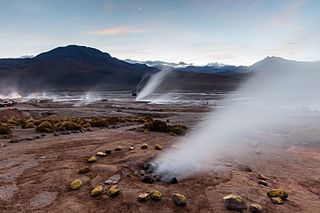
El Tatio is a geothermal field with many geysers located in the Andes Mountains of northern Chile at 4,320 metres (14,170 ft) above mean sea level. It is the third-largest geyser field in the world and the largest in the Southern Hemisphere. Various meanings have been proposed for the name "El Tatio", including "oven" or "grandfather". The geothermal field has many geysers, hot springs, and associated sinter deposits. These hot springs eventually form the Rio Salado, a major tributary of the Rio Loa, and are a major source of arsenic pollution in the river. The vents are sites of populations of extremophile microorganisms such as hyperthermophiles, and El Tatio has been studied as an analogue for the early Earth and possible past life on Mars.

Diana's Punchbowl, also called the Devil's Cauldron, is a geothermal feature located on a small fault in Nye County, Nevada. The spring is exposed through a cup-shaped depression about 50 feet (15 m) in diameter at the top of a domelike hill of travertine about 600 feet (180 m) in diameter. Hot water in the pool of the bowl is about 30 feet below the rim.

Champagne Pool is a prominent geothermal feature within the Waiotapu geothermal area in the North Island of New Zealand. The terrestrial hot spring is located about 30 km (20 mi) southeast of Rotorua and about 50 km (30 mi) northeast of Taupo. The name Champagne Pool is derived from the abundant efflux of carbon dioxide (CO2), similar to a glass of bubbling champagne. The hot spring was formed 900 years ago by a hydrothermal eruption, which makes it in geological terms a relatively young system. Its crater is about 65 m (213 ft) in diameter with a maximum depth around 62 m (203 ft) and is filled with an estimated volume of 50,000 m3 (1,800,000 cu ft) of geothermal fluid.
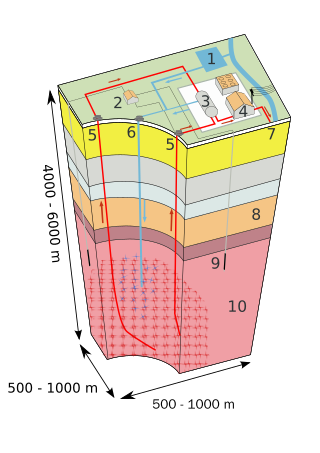
An enhanced geothermal system (EGS) generates geothermal electricity without the need for natural convective hydrothermal resources. Until recently, geothermal power systems have exploited only resources where naturally occurring heat, water, and rock permeability are sufficient to allow energy extraction. However, by far the most geothermal energy within reach of conventional techniques is in dry and impermeable rock. EGS technologies enhance and/or create geothermal resources in this hot dry rock (HDR) through a variety of stimulation methods, including 'hydraulic stimulation'.
Brine mining is the extraction of useful materials which are naturally dissolved in brine. The brine may be seawater, other surface water, groundwater, or hyper-saline solutions from several industries. It differs from solution mining or in-situ leaching in that those methods inject water or chemicals to dissolve materials which are in a solid state; in brine mining, the materials are already dissolved.

La Reforma is a Plio-Pleistocene caldera on the Baja California Peninsula in Mexico. It is part of eleven volcanoes in Baja California, which formed with the Gulf of California during the Miocene, about ten million years ago. Previously, a volcanic arc had existed on the peninsula. The caldera's basement consists of granites and monzonites, formed between the Cretaceous and the Middle Miocene.
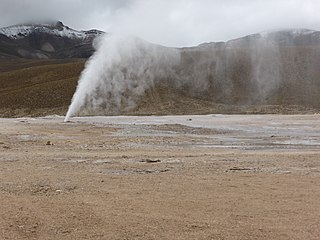
Puchuldiza is a geothermal field in the Tarapacá Region of Chile. It is part of the Central Volcanic Zone of the Andes, close to the active volcano Isluga and several older volcanoes in the neighbourhood; the most recent activity from one of the neighbouring volcanoes was 900,000 ± 300,000 years ago. Geothermal features include geysers and hot springs. Puchuldiza has been inspected for the possibility that it may be suitable as a source for geothermal energy.

Mystic Hot Springs, previously known as Monroe Hot Springs and Cooper Hot Springs are located in northeastern Monroe, Utah. The hot mineral water emerges from the spring at 168 °F (76 °C). The water flows into two smaller pools with temperatures between 92 and 102 °F.
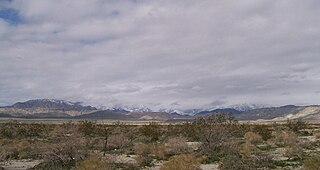
Desert Hot Springs is a geothermal geographic area in Riverside County, California with several hot springs. Since 1941, the California Department of Conservation has recorded approximately 200 geothermal wells that have been drilled in this geographic area; approximately 50 of which are used for commercial spas and pools.
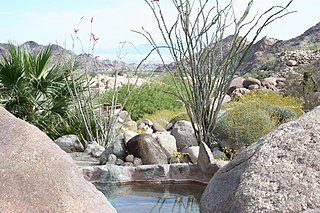
Guadalupe Canyon Hot Springs are a grouping of geothermal springs located near Mexicali, Baja California, Mexico. The hot mineral water is discharged through a number of springs that divert the flow through man-made aqueducts into rock and concrete pools. The hot springs were used by indigenous people for many years before more recent settlers arrived.

Travertine Hot Springs are a group of geothermal mineral springs located near the town of Bridgeport, California.

Mission San Borja Hot Springs are located on the grounds of the historical Misión San Francisco Borja near the town of Rosarito in Baja California, Mexico.

Bartine Hot Springs also known as Bartine Ranch Hot Springs are geothermal hot springs located in the Antelope Valley of the Nevada high desert 40 kilometers northwest of the town of Eureka.
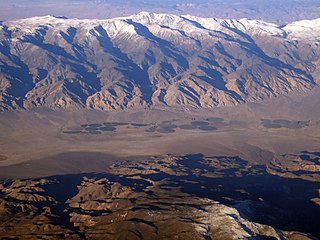
Fish Lake Hot Well, also known as Fish Lake Hot Spring and Fish Lake Valley Hot Well is a geothermal hot spring in Nevada.

Conundrum Hot Springs is a geothermal spring in a remote section of the Maroon Bells-Snowmass Wilderness area of the White River National Forest in Colorado Rocky Mountains.

Akutan Hot Springs is a system of several dozen thermal springs and a geyser in the Akutan geothermal area, Akutan Island, Alaska.

















